CIRCLE TIME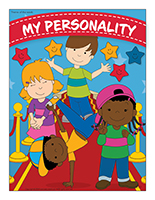
Encourage each child to bring a box or bag filled with different items he/she particularly likes, family photos, etc. to daycare. They can take turns presenting the contents of their box or bag to the group. You can ask parents to send pictures that can be used for crafts and activities. If you wish, pick one or two children who can be the "Stars of the day" or the "Personalities of the day".
You can name one child in the morning and another child in the afternoon. Invite children's parents to be present or let children invite a special guest. Children can show the group one of their baby pictures. Have children guess who is who during circle time. Variation: Glue the pictures on a large piece of cardboard and display them on a wall, where parents will see them. They will enjoy participating in this fun guessing game too.
Animated discussion-My favorite objects
(Open picture game-Personality) Print and laminate the pictures in the format you prefer. Use them to spark a conversation during circle time. Encourage children to bring a box or bag filled with their favorite objects to daycare: family photos (mention to parents that the pictures may be used for a craft or activity and may not be returned), small toys, etc. Select one child or two children each day and invite them to present the contents of their box or bag to the group. You could, for example, have one child share his treasures during circle time and ask a second child to share his items with the group after naptime. It may be interesting to invite parents (or other guests) to attend their child’s presentation. Ask parents to provide baby pictures and have fun guessing who each baby is. If you glue the baby pictures on a large piece of cardboard and display it on a wall near your daycare entrance, parents can join in on the fun!
AREA SETUP
Thematic poster-My personality
(Open thematic poster-Personality) Print, laminate, and display.
Thematic poster-Personalities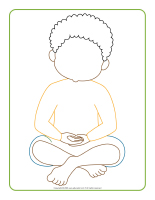
(Open thematic poster-Personalities) Print, laminate, and display all kinds of posters.
Educa-theme- Personalities
(Open educa-theme- Personalities) Print and laminate the elements representing your theme. Use them to present your theme to children (and their parents) while decorating your daycare.
Educa-decorate Personalities
(Open educa-decorate- Personalities) Print, laminate, and cut out the items. Use them to decorate the walls of your daycare and set the mood for your theme.
Star Boulevard
(Model-Star) Print and display. Create a special "boulevard" within your daycare and use it to display children's artwork. With adhesive paper, stick a star on the floor for each child and write their name on their star. If possible, set up your boulevard in an area where children and parents will see it. If you prefer, hang the stars on a clothesline.
Ask you local DVD rental store to give you posters from older movies. Hang pictures of the children in your group next to the posters as if they are movie stars. You may also add pictures of children or well-known characters in a wide range of daily situations and clearly displaying various emotions.

PICTURE GAME
(Open picture game-Personalities) Use the pictures to decorate your daycare or to spark a conversation with your group. Print, laminate, and store the pictures in a Ziploc bag or in your thematic bin.
WRITING ACTIVITIES
Stationery-Personalities
(Open stationery-Personalities) Print. Use the stationery to communicate with parents, in your writing corner, or to identify your thematic bins.
Writing activity-Personalities
(Open writing activities-P like personality) Print for each child or laminate for use with a dry-erase marker.
Activity sheets-Personalities
(Open activity sheets-Personalities) Print and follow instructions.
VARIOUS WORKSHOPS-Personalities
Have fun with these wonderful workshop ideas provided by Caroline Allard.
Construction/Building blocks:
- Blocks of all kinds: Lego, wooden (natural or colored), Bristle, Duplo, Mobilo, etc.
- Cardboard boxes filled with newspaper to create giant blocks.
- Figurines.
- Different means of transport (cars, trucks, airplanes, boats, trains).
- A garage, a toy car mat, cardboard cylinders to represent tunnels, and traffic signs.
- Farm animals, zoo animals, reptiles, pet figurines, etc.
- Various natural elements that can be used for constructions (branches, rocks, bark, etc.).
Arts & crafts:
- Easel with large sheets of white paper and poster paint.
- Paintbrushes, sponges, rollers, and old toothbrushes in different sizes.
- Water paint blocks.
- Finger paint and glossy paper.
- Chalkboard and chalk.
- Scissors and scrapbooking scissors.

- Scrapbooking hole-punches.
- Glue sticks, white glue, glitter glue, liquid glue.
- Adhesive paper.
- Feathers, pompoms, pipe cleaners, yarn, ribbon, confetti.
- Construction paper, variety of colors.
- White and colourful cardboard.
- Cellophane, tissue paper, wrapping paper.
- Paper plates, empty toilet paper rolls, cone-shaped drinking glasses.
- Popsicle sticks, toothpicks.
- A variety of recycled items.
- Catalogues and flyers.
- Stencils.
- A tablecloth to protect the table.
Drawing:
- Coloring pages related to routines, workshops, friendship, your group's name.
- Markets, wooden coloured pencils, waxed crayons.
- Pastels, colourful chalk.
- HB pencils and erasers.
- Rulers and stencils.
- Stamps and stamp pads.
Role play: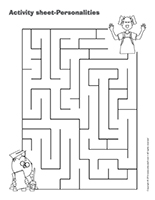
- Everything you can get your hands on children can use for dress-up play.
- Adult and children's clothing items (ask parents for items they no longer need), handbags, shoes, belts, hats, jewellery...
- Old electrical appliances (with electrical cords removed), dishes, a table and chairs, plastic food items, empty food containers.
- Dolls, doll clothing, a doll bed, a high chair.
- Puppets and a puppet theatre.
Manipulation:
- Memory game involving pictures related to back to school season.
- Puzzles.
- Modeling dough that can be used to sculpt and create various shapes with cookie cutters.
- Necklace beads in a variety of colors, sizes, and shapes.
- Lacing activities.
- Books and games that offer lacing, zipping, and buttoning challenges.
- Toys that require assembly or involve parts that fit one inside the other.
- Lotto games, memory games, board games.
- Card games.
- Magnetic numbers and letters.
- Magnets of all kinds along with cookie sheets.
Pre-reading:
- Storybooks, fairy tales, picture books.
- Book and CD sets along with headphones.
- Homemade picture books containing pictures of the children in your group.
- Alphabet picture books.
- Magazines containing lots of pictures.
- Felt board along with characters that can be used to create stories.
- Comfortable armchairs, cushions, a small table.
- Posters that can be used to decorate the walls.
- A small area children can go to when they want tranquillity.
- A small table lamp.
Pre-writing:
- Items drawn with dotted lines children must trace.
- Games where children must find the differences/errors between two scenes.
- Hunt and seek games.
- Various activity sheets children can use to practice their writing and drawing skills.
- Games with educatall.com word flashcards.
- An old typewriter children can use to print real letters.
- Magnetic numbers and letters.
- A whiteboard along with dry-erase markers.
Sensory bins:
- Sand/water table.
o If you wish, you can replace the sand or water with oats, lentils, uncooked pasta, sunflower seeds, cotton balls, leaves, dried peas, cry cereal, etc. Of course, the possibilities may be limited by the ages of the children in your group.
- Spray bottles.
- Funnels, empty containers that can be filled and emptied over and over again.
- Tiny objects that can be hidden among the contents of your bins.
- Kitchen utensils children can use to stir and mix the contents of your bin.
- Drinking straws, sponges.
- Measuring cups, sieves.
- Objects that float and others that sink.
Early science/nature:
- Posters of different types of animals and natural phenomena.
- A map, a globe, an atlas.
- Plants, dirt, a vivarium, a terrarium, gardening tools.
- Magnifying glasses and plastic gloves.
- Items found in nature (logs, branches, leaves, rocks, etc.).
- A scale.
- Funnels, eyedroppers.
- Containers of all kinds for mixing various items together.
Music:
- Posters of musical instruments.
- A tape recorder and microphone children can use to record themselves when they sing.
- Music from different countries, a variety of musical styles.
- A container filled with several musical instruments (rhythmic sticks, triangles, drums, cymbals, a xylophone, bells, etc.)
LANGUAGE ACTIVITIES
Word flashcards-My personality
The flashcards may be used during circle time to spark a conversation or in your reading and writing area. They may also be used to identify your thematic bins. (Open word flashcards-Personality) (Open giant word flashcards-Personality) calm, honest, shy, sensitive, playful, energetic, independent, sociable, fun, responsible, helpful.
My personality traits
Give each child a piece of white cardboard and help them cut out an oval that is big enough for them to insert their face. Around the oval cutout, have children draw or glue elements that represent their personality (ex. a picture of someone who is thinking for a thoughtful child, fireworks for an energetic child, a picture of someone signaling to be quiet for a calm child, etc.). Next, invite children to hold their oval in front of their face and name the various elements that represent their personality.
Encourage children to comment on the personality traits chosen by their peers. What would they add? Are they surprised by certain choices?
Educa-chatterbox-My personality
(Open educa-chatterbox-Personality) Print and laminate the cards. To create your chatterbox, you will need an empty shoebox or a small bin that you can decorate as you see fit. Fill it with tiny objects, illustrations, pictures, and accessories related to your theme. To help you, we have created a series of cards that you may use. During circle time or, for example, when children are waiting for their lunch, have them take turns picking a card or object out of your chatterbox and naming the corresponding item.
Word flashcards-Personalities
(Open word flashcards-Personalities) Print. The word flashcards may be used to spark a conversation with your group, in your reading and writing corners, or to identify your thematic bins. small, big, baby, child, calm, active, games, food, friends, size, hair, feeling
ACTIVITIES FOR BABIES
Mirror, mirror
Simply hold a mirror in front of each child's face to help them see themselves and increase their self-awareness.
Send it to me
Sit on the floor with a child. Simply roll a ball towards him/her as you say his/her name. Say your name as the child rolls the ball back to you.
PHYSICAL ACTIVITY AND MOTOR SKILLS
Personality hop
(Open game-Personality hop) Print, laminate, and cut out the cards. Use colorful tape to draw a line on the floor, dividing your daycare into 2 playing areas. To begin, invite children to stand on the line. Pick 2 cards and set each one on a different side of the line. You could, for example, say, “Do you feel that your personality is best represented by a superhero or a princess?” Children hop into the playing area containing the corresponding card. Continue with other sets of cards so that children hop from one side of the line to the other side as many times as possible.
Personality “jumping jacks”
First, show children how to perform jumping jacks. Next, associate the 2 steps that make up this exercise to different personality types. When you name a personality trait associated with an extroverted personality, children must jump and form an “X” with their arms and legs, taking up as much space as possible. When you name a personality trait associated with an introverted personality, children must stand tall with their arms pressed on either side of their body, to represent turning inwards. (Open personality jumping jacks) Print, laminate, and cut out the cards.
Modeling dough activity placemats-My personality
(Open modeling dough activity placemats-Personality) Print and laminate. Let children pick a placemat and provide modeling dough. Encourage them to use the dough to fill or reproduce the shapes that are on their placemat.
Educ-clothespins-My personality
(Open educ-clothespins-Personality) Print and laminate. Children must find and identify the correct picture by pressing a clothespin on it.
Playing cards-My personality
(Open playing cards-Personality) Print and laminate. Give each child the same number of cards. They can take turns hiding their cards within the daycare. When all the cards have been hidden, the hunt begins! Children race to find as many cards as possible.
Race to collect the cards-My personality
(Open playing cards-Personality) Print and laminate several playing cards and hide them throughout your daycare or yard. Divide your group into 2 teams. When you give the signal, children race to collect as many cards as possible during a predetermined period, for example 3 minutes.
My favorite song
Invite children to sit in a circle. At the start of the game, hand one child a crown that he can wear on his head. The crown is to be passed around the circle, to the sound of music. When the music stops, the child who is wearing the crown must begin singing a song of his choosing. The rest of the group chimes in. The duration of this game will vary per children’s level of interest. Each child must set the crown on his head before passing it to the child sitting to his right.

My favorite clothing items
Look through children’s change of clothes to find clothing items belonging to each child (you can use their outdoor clothes if you prefer). Hide with a child and have him put the clothing items belonging to one of his peers on. The other children must guess who the items belong to. You’ll be surprised at how easily children recognize their friends’ clothing items!
Giant homemade memory game-Politeness
(Open picture game-Politeness) Print 6 pictures twice. Use 12 paper plates that are the same color and press a picture on each one. Arrange the plates upside down on the floor or table. Children take turns turning 2 plates over. The object of the game is to find matching pairs. If a child turns over 2 different pictures, his turn is over. He sets the pictures upside down for the next player. If a child finds matching pictures, encourage him to name the illustrated personality traits or actions. If he succeeds, he can keep the plates.
“Please” and “thank you”
(Open politeness game) Divide your group into 2 teams: a “Please” team and a “Thank you” team. Set the printed words in an opaque bag. Pick one word at a time out of the bag and read it out loud. Every time the “Please” team” hears you say “Please”, they must stand up and sit back down. In the same way, every time the “Thank you” team hears you say “Thank you”, they must stand up and sit back down. Whenever you read a different word, children from both teams must remain seated.
Mood swings
Using sidewalk chalk, draw several large emojis on a paved surface, in a line. Invite children to stand on an emoji. Name a number. Children must perform the corresponding number of hops, jumping from one emoji to the next. When they reach the last emoji, they run back to the first emoji to complete their hops if necessary. Encourage children to act out the emotion associated with the emoji they land on. For example, if a child finds himself on the sad emoji, he could pretend to cry. Continue the game with a new number.
Mirror, mirror
Simply hold a mirror up in front of each child so that they can admire their reflection.
Roll to me
Sit on the floor with one or two children and simply roll the ball towards them as you say their name. Say your name when they push or roll the ball back to you.
Guess who I am talking about
Invite children to sit in a circle. Name characteristics of a specific child (hair color, eye color, clothing details, sister's name, etc.). Children must identify the child you are describing. The child who guesses correctly can describe a child for the next round.

I am growing
Touch a child with a magic wand. He/she is instantly transformed. He/she becomes a baby, a child, or an adult. The child acts out various roles and actions, depending on the transformation you chose for him/her.
Just like the big kids
Select a child who will be the game leader. He/she performs a variety of actions and gestures that the other children in your group must imitate.
I live there!
Go for a walk with your group and, if possible, walk by each child's house to give them the opportunity to recognize it. If children live too far away, try to walk by a store or restaurant they like or the house of someone they know very well (grandparent, friend, etc.).
My clothes
Before going outside with your group, especially during colder months, set all the clothing items belonging to the children in your group in a pile on the floor. Children take turns searching for an item that belongs to them. Once they all have everything they need, encourage them to get dressed to go play outside.
Let's play...
Invite your "Star of the day" or "Personality of the day" to lead an outdoor game or activity for the group. If you prefer, and if you don't think it will cause conflicts among the children in your group, you can encourage him/her to pick one or two friends to play a board game or take part in another special activity with him/her.
This is me!
Give each child's parents a large piece of cardboard and ask them to help their child cut pictures that represent his/her personality as well as his/her likes and dislikes out of magazines. Display their personalized posters in a hallway or in your daycare entrance.
My genealogical tree
(Open genealogical tree) Print for each child. Parents must complete the genealogical tree with their child. Encourage them to be creative and transform the model to represent their family. Children can take turns presenting their family tree to the group. When they are done, help them display it on a special wall. If you don't wish to have the entire group present their family tree at the same time, you can invite only the "Star of the day" or the "Personality of the day" to present his/her family tree each day.
COGNITIVE ACTIVITIES
Color the characters per their personality
(Open worksheet-Color the personalities) Print for each child. Read one statement at a time. Children must identify the corresponding character and color his or her sweater using the appropriate color.
Build a personality
(Open build a personality) Print the shapes and a face outline for each child. Print, laminate, and cut out the cards representing various personality traits. Give each child a card. Encourage them to cut out the shapes required to represent the personality trait shown on their card and glue them on the face outline.
My favorite foods
Give each child a paper plate and provide several grocery store flyers. Invite children to cut food items that they like to eat and glue them on their plate. Encourage them to present their plate to the group. They can, for example, state whether they eat each food item for breakfast, lunch, or dinner.
Educ-ascending-descending-My personality
(Open educ-ascending-descending-Personality) Print and laminate the cards. Children must arrange identical items in ascending or descending order.
Educ-math-My personality
(Open educ-math-Personality) Print and laminate for durable, eco-friendly use. Children must count the items in each rectangle and circle the corresponding number.
Coloring hunt and seek-My personality
(Open coloring hunt and seek-Personality) Print and laminate. Children must find and color the items in the scene.
Smiley face stamping
(Open smiley face stamping) Print a worksheet for each child. They must stamp the correct number of smiley faces in each row, per the number indicated.
Educ-math-Personalities
(Open educ-math-Personalities) Print and laminate for durable, eco-friendly use. Children must count the objects in each rectangle and circle the corresponding number.
Magnifying glass game-Personalities
(Open magnifying glass game-Personalities) Print. Laminate the board game and cards. Cut out the cards and deposit them in a box or bag. Children pick a card and search for the item on the board game, using a magnifying glass. Once they have found the matching item, they set the card in the corresponding square, on the board game.
Educ-same and different-Personalities
(Open educ-same and different-Personalities) Print and laminate for durable, eco-friendly use. Children must circle the illustration that is different in each row.
Hunt and seek-Personalities
(Open hunt and seek-Personalities) Print and laminate. Children must pick a card and search for the corresponding item in the scene.

Dominoes-Personalities
(Open dominoes-Personalities) Print, glue the pages on heavy cardboard, and laminate. Cut the cards. This game is for 2 to 4 players. Each child picks 5 cards. Arrange the remaining cards in a stack on the table. Place one card. The first player tries to match a card to one of the illustrations shown on the initial card. The second player does the same and so on. If a player does not have a matching card, he/she must pick an additional card from the stack. If this card cannot be played either, his/her turn is over.
MORAL AND SOCIAL ACTIVITIES
Scrapbook-My personality
Print this new scrapbook page for each child. (Open scrapbook-Personality) Insert it in each child’s scrapbook.
Kindness cards
(Open kindness cards) Print and laminate the cards so that you can distribute them among the children in your group.
Privilege cards
(Open privilege cards) Print and laminate the cards so that you can distribute them among the children in your group.
My album about me
(Open album about me) Print for each child. Throughout the theme, complete the pages with the children in your group.
Camera
(Open model-camera) Print the model. Trace it on heavy cardboard and cut it out. Each child will have his/her own camera. Explain how they can use their camera to "capture" images or activities they enjoy throughout the day. Before they leave in the afternoon, have each child draw their favorite image (Open models-pictures) for the day and present it to the group.
My name
Sit in a circle with your group and try to find words that rhyme with each child's name.
I want to be a...
Collect several costumes and clothing items children can use to dress up. Ask children what they want to be when they grow up and help them dress up to represent the profession they name. Take pictures of the children in your group and display them in your daycare.
I am as big as...
Display a growth chart on a wall and measure the children in your group. Stick a picture of each child next to his/her measurement. When you are done, invite children to stand in line, from shortest to tallest, from tallest to shortest, from the lightest hair color to the darkest hair color, etc.
Personality of the day
(Open poster-Personality of the day) Print and display on the door of your daycare. Add the picture of a different child each day. Make sure each child gets his/her turn during the theme. The "Personality of the day" can show the other children in the group their photo album or bring a special toy to daycare to share with the group. If you wish, you can also encourage children to bring their favorite movie to daycare to watch it with their friends or their favorite CD if you are willing to play it, for example during free play. Children may also enjoy sharing their favorite storybook with the group. No matter what you choose to do, be sure to make room for plenty of privileges. Being the "Personality of the day" must be very special!
My self-esteem
Pay close attention to the successes of the children in your group. Be sure to express how proud you are of them whenever they do something well or perform a kind gesture. Display their artwork for everyone to see and take pictures of their various creations so you can print the pictures and show them to others.
I'm watching closely
Sit in a circle with your group. Have your "Personality of the day" (or another child) sit in the centre of the circle. Ask the children in your group to name tiny details and characteristics of the child sitting in the centre (hair color, eye color, sweater buttons, sock color, etc.). Afterwards, give each child a piece of paper and invite them to draw the child. If you prefer, you can hang a large piece of paper on a wall and encourage children to draw their friend together.
I am...
(Open emotions characters) Laminate the cards. Have children pick the card that best represents how they are feeling and encourage them to explain their choice. These cards can be used for many activities and games, for example mime games. Use your imagination!
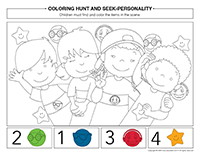
I am me and you are you
For this activity, divide your group into pairs and have each child stand, facing his/her partner. One child performs an action or gesture and the other child must mirror his/her partner.
Personality mimes
Children sit with a partner, face to face. One child uses his/her face to represent an emotion and his/her partner must do the same. For example, if a child pretends to cry, his/her partner must pretend to cry too.
EARLY SCIENCE
Our differences
Apply paint to the bottom of children's hands and feet and press them on paper. Use magnifying glasses to observe and identify the differences, resemblances, etc. Use this activity to help children notice how each person's nose, eye color, hair color, etc. are different.
What I like, what you like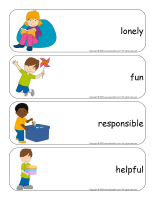
Prepare several small containers filled with different ingredients. Have children take turns tasting the contents of each container. Some will like bitter-tasting items, others will prefer salty items, and, of course, many will like the sweet items.
CULINARY ACTIVITIES
My favorite recipe
Ask children what their favorite recipe or food is and integrate as many recipes and foods in your weekly menu. If you wish, you could ask parents to share their child's favorite recipe with you. Use the recipes to create a small recipe book.
Happy pizza
Give each child a small ball of pizza dough and let them roll it out and spread or sprinkle the ingredients of their choice on top. Encourage them to use peppers, pepperoni, tomatoes, olives, etc. to create a smiling face.
Gingerbread cookie dough recipe
Create different sizes of gingerbread men with the children in your group.
Ingredients: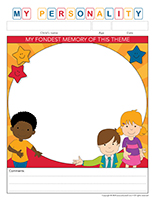
- ¼ cup of softened butter or margarine
- ¼ cup of white sugar
- 1 egg
- ¼ cup of molasses
- 1 ½ cup of all-purpose flour
- ¼ teaspoon of baking soda
- ¼ teaspoon of salt
- ¼ teaspoon of ground cloves
- ¼ teaspoon of cinnamon
- ¼ teaspoon of ginger
- Candy pieces for decorating
- In a bowl, beat butter and sugar until smooth. Incorporate egg and molasses.
- Combine dry ingredients and add them to creamy mixture. Mix well.
- Wrap dough in plastic wrap and refrigerate for at least two hours.
- Roll out the dough on a floured surface. It should be approximately ¼ inch thick.
- Use cookie cutters or a plastic knife to cut gingerbread man shapes. Deposit your gingerbread men on a lightly greased cookie sheet.
- Bake cookies at 350 °F on the top rack for 12 to 15 minutes or until cookies are firm and golden. Let cookies cool on a wire rack.
- Let children decorate the cookies as they wish.
For a simplified version, use store-bought gingerbread cookie dough.

ARTS & CRAFTS
My food preferences
Give each child three paper plates. Label them so that each one will represent a different meal (breakfast, lunch, dinner). Provide several grocery store flyers. Ask children to cut out food items they like to eat and glue them on the correct plate.
Bravo!
Draw an oversized hand on a large piece of white cardboard. Decorate the hand with your group and laminate it. Display the decorated hand on a wall, at children's level. Whenever you spot a child being kind or helpful or when a child succeeds a task, have them "high five" the giant hand. With time, children will begin to use it independently.
Our personality quilt
Ask parents to provide several pictures of their child (or photograph children yourself as they are playing). Help children glue their pictures on pieces of felt. Let them decorate them with colourful accessories. Assemble all the pieces of felt and hang your personality quilt within your daycare.
Me
Set a large piece of white paper on the floor and trace the outline of each child's body. Encourage children to use paint to "dress" their silhouette. They can also draw or paint their hair, eyes, and mouth.
My crafty portrait
(Open face outline) Print for each child. Invite children to tear construction paper with their fingers (or cut it with scissors). They can use the pieces of paper to represent their facial features. Of course, they can draw smaller details too. This can also be done on a paper plate if you prefer.
A "me" puppet
(Open faces, arms, legs) Print the various parts and set them on a table, in front of your group. Give each child a brown paper bag and ask them to create a puppet that looks like them. Encourage them to look at their reflection in a mirror to identify their unique features.
My mirror
For each child, stick an acetate sheet on a mirror. Have them paint their portrait over their reflection in the mirror. You may be surprised by the results! If you prefer, they could also use dry-erase markers.
My mobile
Give each child a metal clothing hanger as a base for their mobile. Encourage children to cut things they like or things they feel represent their personality out of catalogues and magazines. They can also draw different items or people that are important to them. Help them hang everything from their hanger with different lengths of string.
My mask
(Open face-emotions) Print and set everything in the centre of the table. Let children use the items to represent their own face on a paper plate. Cut out two circles for the eyes. They may also use pieces of yarn to represent their hair and markers to draw facial features. Make a hole on either side of the plate and thread string or elastic through so children can wear their mask in front of their face. Organize your very own personality parade.
COLORING PAGES
(Open coloring pages theme-Personalities) Print for each child.
CREATIVE COLORING
(Open creative coloring-Personalities) Print for each child. Invite children to draw themselves as adults. Their drawing can reflect what they would like to be when they grow up.
Have fun
The educatall team
 Home
Home Theme activities
Theme activities
 Babies and toddlers
Babies and toddlers
 Arts and crafts
Arts and crafts
 Science
Science
 Creative recipes
Creative recipes
 Tips and tricks
Tips and tricks
 Special needs
Special needs
 Extra activities
Extra activities
 Educ-TV
Educ-TV
 Newsletter
Newsletter  Online store
Online store Educatall club
Educatall club

